NCERT Solutions for Exercise 11.1 Class 10 Maths Chapter 11 - Constructions
NCERT Solutions For Class 10 Maths Chapter 11 Exercise 11.1
NCERT Solutions for Exercise 11.1 Class 10 Maths Chapter 11 Constructions are discussed here. These NCERT solutions are created by subject matter expert at Careers360 considering the latest syllabus and pattern of CBSE 2023-24. Class 10 Maths ex 11.1 enlists a few practice problems on the construction of triangles with given measurements base and heights. In the later section some more questions, terms related to the property of triangles, and how its construction can be made in two-dimensional geometry will be discussed.
10th class Maths exercise 11.1 answers are designed as per the students demand covering comprehensive, step by step solutions of every problem. Practice these questions and answers to command the concepts, boost confidence and in depth understanding of concepts. Students can find all exercise together using the link provided below.
Download Free Pdf of NCERT Solutions for Class 10 Maths chapter 11 exercise 11.1
Assess NCERT Solutions for Class 10 Maths chapter 11 exercise 11.1
Constructions Class 10 Chapter 11 Exercise: 11.1
In each of the following, give the justification of the construction also:
Q1 Draw a line segment of length 7.6 cm and divide it in the ratio 5 : 8. Measure the two parts.
Answer:
Steps of construction:-
(i) Draw a line segment AB of measurement 7.6 cm (length).
(ii) Now draw an acute angle AC with line segment AB.
(iii) Now cut 13 equal points on the line AC where the zeroth point is A.
(iv) Join the 13th point with point B. So the new line is BA 13 .
(v) Now, from point A 5 draw a line parallel to BA 13 on line AB. Name the point as D.
The point D is the required point which divides the line segment in the ratio of 5: 8.
The length of the two parts obtained is 2.9 cm and 4.7 cm for AD and DB respectively.
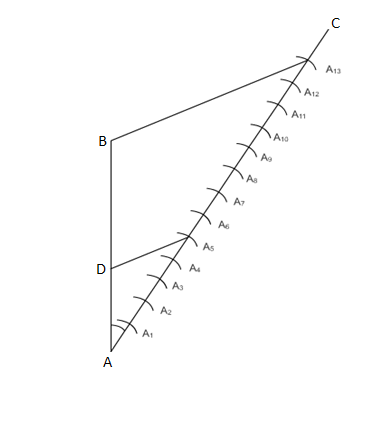
Justification:- In the figure, we can see two similar triangles: $\Delta ADA_5$ and $\Delta ABA_{13}$
Thus $\frac{AA_5}{A_5A_{13}}\ =\ \frac{AD}{DB}\ =\ \frac{5}{8}$ .
Answer:
Steps of construction are:-
(i) Firstly draw a line segment AB of length 4 cm.
(ii) Now cut an arc of radius 5 cm from point A and an arc of 6 cm from point B.
(iii) Name the point of intersection of arcs to be point C.
(iv) Now join point AC and BC. Thus $\Delta$ ABC is the required triangle.
(v) Draw a line AD which makes an acute angle with AB and is opposite of vertex C.
(vi) Cut three equal parts of line AD namely AA 1 , AA 2 , AA 3 .
(vii) Now join A 3 to B. Draw a line A 2 B' parallel to A 3 B.
(viii) And then draw a line B'C' parallel to BC.
Hence $\Delta$ AB'C' is the required triangle.
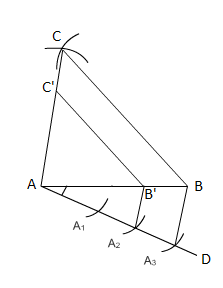
Answer:
Steps of construction are:-
(i) Firstly draw a line segment AB of length 5 cm.
(ii) Now cut an arc of radius 6 cm from point A and an arc of 7 cm from point B.
(iii) Name the point of intersection of arcs to be point C.
(iv) Now join point AC and BC. Thus $\Delta$ ABC is the required triangle.
(v) Draw a line AD which makes an acute angle with AB and is opposite of vertex C.
(vi) Cut seven equal parts of line AD namely AA 1 , AA 2 , AA 3 , AA 4 , AA 5 , AA 6 , AA 7 ,.
(vii) Now join A 5 to B. Draw a line A 7 B' parallel to A 5 B.
(viii) And then draw a line B'C' parallel to BC.
Hence $\Delta$ AB'C' is the required triangle.
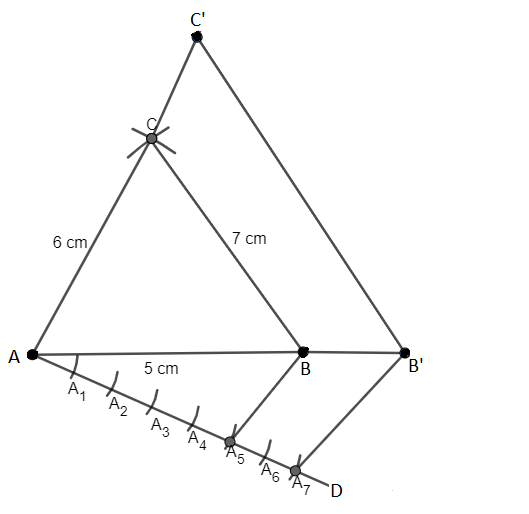
Answer:
Steps of construction:-
(i) Draw a line segment AB of length 8 cm.
(ii) Cut arcs taking point A and point B as the center. Draw the line to intersect on line segment AB. Mark the intersecting point as point D.
(iii) Cut arc of length 4 cm on the same line which will be the altitude of the triangle.
(iv) Name the point as C. Then $\Delta$ ABC is the isosceles triangle.
(v) Draw a line AX which makes an acute angle with AB and is opposite of vertex C.
(vi) Cut seven equal parts of line AX namely AA 1 , AA 2 , AA 3 .
(vii) Now join A 2 to B. Draw a line A 3 B' parallel to A 2 B.
(viii) And then draw a line B'C' parallel to BC.
Hence $\Delta$ AB'C' is the required triangle.
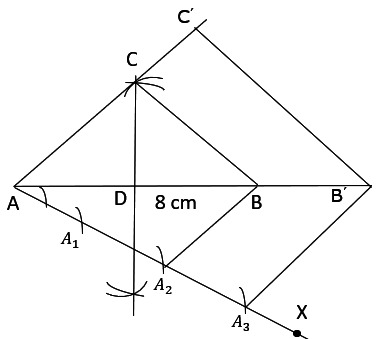
Answer:
Steps of construction:-
(i) Draw a line segment BC with a measurement of 6 cm.
(ii) Now construct angle 60 o from point B and draw AB = 5 cm.
(iii) Join point C with point A. Thus $\Delta$ ABC is the required triangle.
(iv) Draw a line BX which makes an acute angle with BC and is opposite of vertex A.
(v) Cut four equal parts of line BX namely BB 1 , BB 2 , BB 3 , BB 4.
(vi) Now join B 4 to C. Draw a line B 3 C' parallel to B 4 C.
(vii) And then draw a line B'C' parallel to BC.
Hence $\Delta$ AB'C' is the required triangle.
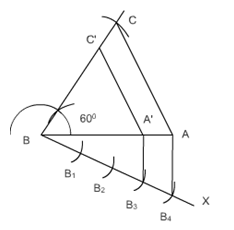
Answer:
Steps of construction:-
(i) Draw a line segment BC.
(ii) Now draw an angle $\angle$ B = 45 o and $\angle$ C = 30 o and draw rays in these directions.
(iii) Name the intersection of these lines as A.
(iv) Thus $\bigtriangleup ABC$ is the required triangle.
(v) Draw a line BX which makes an acute angle with BC and is opposite of vertex A.
(vi) Cut four equal parts of line BX namely BB 1 , BB 2 , BB 3 , BB 4.
(vii) Now join B 3 to C. Draw a line B 4 C' parallel to B 3 C.
(viii) And then draw a line B'C' parallel to BC.
Hence $\Delta$ AB'C' is the required triangle.
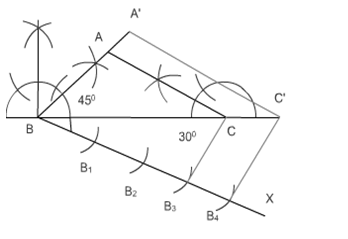
Answer:
Steps of construction:-
(i) Draw a line segment AB having a length of 4 cm.
(ii) Now, construct a right angle at point A and make a line of 3 cm.
(iii) Name this point C. Thus $\Delta$ ABC is the required triangle.
(iv) Draw a line AX which makes an acute angle with AB and is opposite of vertex C.
(v) Cut four equal parts of line AX namely AA 1 , AA 2 , AA 3 , AA 4 , AA 5 .
(vi) Now join A 3 to B. Draw a line A 5 B' parallel to A 3 B.
(vii) And then draw a line B'C' parallel to BC.
Hence $\Delta$ AB'C' is the required triangle.
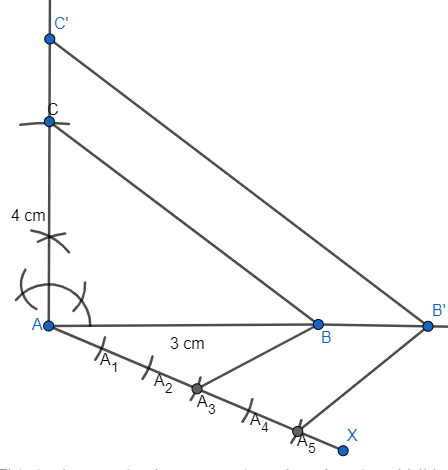
More About NCERT Solutions for Class 10 Maths Chapter 11 Exercise 11.1
This section contains the extra information the source and scenario of content present in exercise 11.1 Class 10 Maths. Starting from the first. This exercise 11.1 Class 10 is there to represent the problems based on building triangles over conditions provided and given measurements i.e. AB and AC in triangle ABC. As the number increases in ascending for the questions, concepts get changed like here will be discussing other questions based on the property of the triangle mentioned in the previous chapter. So in simple words, we say Class 10 Maths chapter 11 exercise 11.1 is basically a Platform in the roadmap to learn more about 2D Geometry for beginners.
Also Read| Constructions Class 10 Notes
Benefits of NCERT Solutions for Class 10 Maths Chapter 11 Exercise 11.1
NCERT solutions for Class 10 Maths chapter 11 exercise 11.1 are important as to get better understanding over the subject.
Another benefit of exercise 11.1 Class 10 Maths is makes students understand terminologies like construction procedures and justification of the given diagram.
Student can solve most of the question provided to him/her in his HW, exams or test.
Also see-
NCERT Solutions Subject Wise
Frequently Asked Questions (FAQs)
The sum of all angles of triangle is 180 degrees
The radius of the given circle is 10cm and point A is 8 cm from center of circle hence
The point lies inside of the circle hence no tangents can be traced from that point
A perpendicular line segment traced from the vertex of a triangle to the opposite side is called an Altitude
There are a total of 2 exercises in chapters 11 ie exercise 11.1 and 11.2
Toughness of any chapter exercise and topic is based on the amount of hard work required to master that thing. As far as this chapter is concerned students need to follow definite path in order to solve each and every question of maths
Questions related to CBSE Class 10th
On Question asked by student community
Hello
Visit the official website of the Rajasthan Education Department or the Shala Darpan portal.
Look for the “Latest News” or “Examination” section. Check school notice boards or ask your class teacher for updates.
Some district education office websites may also upload the key. Avoid unofficial websites as they may provide incorrect or fake keys.
Hrllo,
If you want to view the CM Shri School 2025-26 admission test result , visit the official website, click on the "CM Shri Schools Admission Test - 2025." then select the "CM Shri Admission Test Result 2025 - Merit List" link. Here you need to log in with your credentials and view or download the merit list pdf.
I hope it will clear your query!!
Hello aspirant,
Fairness and equal opportunity are guaranteed by the rigorous merit-based admissions process at CM Shri Schools. The merit list will be made public on edudel.nic.in, the official DOE website. Based on how well they did on the admission exam, students will be shortlisted.
To know the result, you can visit our site through following link:
https://school.careers360.com/articles/cm-shri-school-admission-test-result-2025
Thank you
Hello
-
The CM Shri School Admission Test was conducted for students seeking quality education.
-
The result and selection list are expected to be released in the last week of September 2025.
-
Students who qualified will get admission into CM Shri Model Schools across the state.
-
The official list of selected students will be available on the edudel.nic.in website.
-
Candidates can check their names in the merit list PDF once uploaded.
-
Selection is based on the student’s performance in the entrance exam.
-
Keep checking the official site or the school notice board for timely updates.
Check - https://school.careers360.com/articles/cm-shri-school-admission-test-result-2025
You can check CM Shri school result here: https://school.careers360.com/articles/cm-shri-school-admission-test-result-2025 Thank You.
Popular CBSE Class 10th Questions
Applications for Admissions are open.
This ebook serves as a valuable study guide for NEET 2025 exam.
NEET Previous 10 Year Questions
Get nowThis e-book offers NEET PYQ and serves as an indispensable NEET study material.
JEE Main Important Physics formulas
Get nowAs per latest syllabus. Physics formulas, equations, & laws of class 11 & 12th chapters
JEE Main Important Chemistry formulas
Get nowAs per latest syllabus. Chemistry formulas, equations, & laws of class 11 & 12th chapters
JEE Main high scoring chapters and topics
Get nowAs per latest 2024 syllabus. Study 40% syllabus and score upto 100% marks in JEE
JEE Main Important Mathematics Formulas
Get nowAs per latest syllabus. Maths formulas, equations, & theorems of class 11 & 12th chapters
